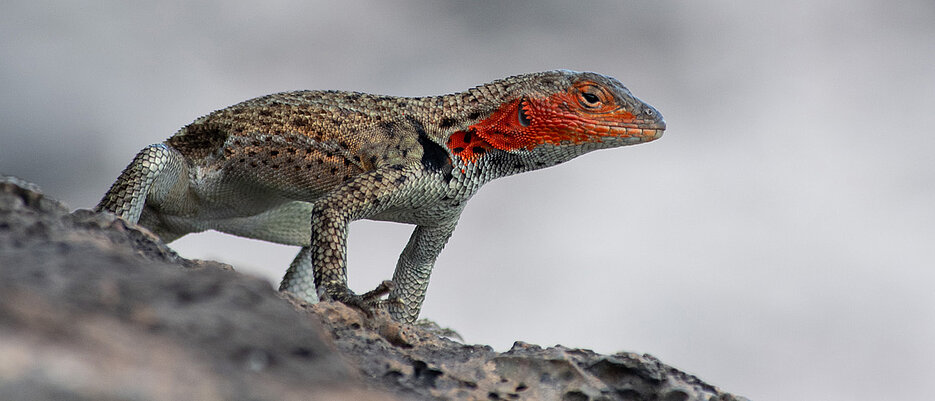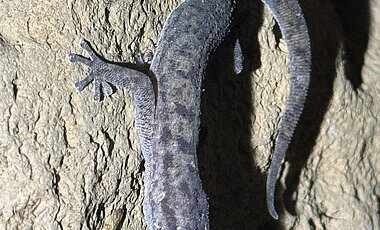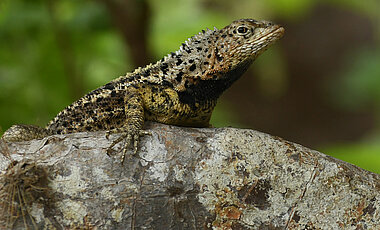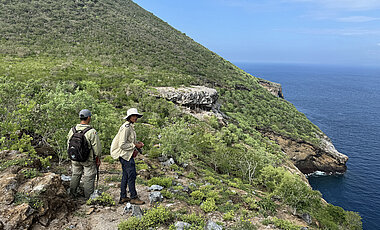Poison as a Means of Species Protection
30.08.2024The Galápagos Islands are struggling with invasive species. To counter this, conservationists resort to drastic measures for removal. A biologist from Würzburg is investigating how these impact native lizards and their food webs.

In 1875, Charles Darwin admired uniqueness of species found on the Galápagos Islands in his work A Naturalist’s Voyage Round the World, in particular the group of birds described today as Darwin's finches
In addition to these birds, the famous giant tortoises, marine iguanas, and sea lions, the archipelago, located around one thousand kilometers west of the Ecuadorian coast, is also home to less prominent but ecologically important representatives, such as lava lizards and geckos. Eleven species of lava lizards and ten species of leaf-toed geckos are endemic to the Galápagos Islands, meaning they only occur there. And like their better-known neighbors, they also face various challenges, including the threat from invasive species.
Biologist Kirtana Kumar is taking a closer look at these animals as part of her doctoral thesis at Julius-Maximilians-Universität Würzburg’s (JMU) Chair of Conservation Biology and Forest Ecology. Her research is in collaboration with Ecuadorian NGO, Fundación de Conservación Jocotoco and UK NGO, Durrell Wildlife Conservation Trust. She is doing this following a seemingly drastic undertaking: The eradication of rats and stray cats on Floreana Island, the sixth largest island in the archipelago.
Invasive Species as a Threat
Since European sailors first colonised the islands in the 1800s, the native flora and fauna have had to contend with rodents, goats, dogs and cats, among others. Such invasive species have already caused lasting damage to many ecosystems and wiped out native species, which are often defenceless against these unknown threats. The negative impact of invasive species is not only on the Galápagos Islands, but is a global issue.
Conservation organizations sometimes resort to drastic measures to get the unwanted guests under control. On Floreana Island – which at 173 square kilometers is roughly the size of the city of Karlsruhe – poison bait was distributed by helicopter in December 2023 to rid the island of rats and stray cats. At least the former seems to be promising in its success according to initial impressions.
"Such eradication campaigns have already been carried out successfully on other islands, particularly in New Zealand. The Galápagos Archipelago also has the potential to achieve such successes across its islands, while taking the opportunity to prioritise monitoring the impacts of these campaigns on native species and the ecosystem", explains Kirtana Kumar. In her doctoral thesis, she wants to investigate how the use of poison and the disappearance of rats affects the population of lava lizards and geckos. She also wants to trace the path of the poison through the island's food web and investigate the soundscape of native birds following the eradication campaign.
Potential Support for Planned Reintroductions
An important factor: while the toxin is lethal to mammals, it is not for reptiles. Therefore, the lizards are spared but potentially contain toxins in their system from the eradication. The situation is different with birds, however, which is particularly important regarding the planned reintroductions of displaced predatory bird species back to Floreana Island.
Lizards are an important source of food for owls and the Galápagos hawk. So, understanding the abundance of lizards, as well as levels of poison in them and the ecosystem is valuable. "We know that the toxin has a considerable half-life and could therefore be passed on from the lizards to potential predators, but we don’t yet understand the clear pathways and the risk factor. This has been a downfall of previous eradications and reintroductions with this scenario" says Kirtana Kumar.
Investigating this allows conservationists to better manage future eradications and reintroductions to reduce the risks involved. To this end, the biologist has collected mainly insects and lizards which are now being subjected to toxin analysis. Additional samples including plants and birds will be used for stable isotope analysis to build the food web of Floreana Island to understand the interactions of species and the toxic transfer in the ecosystem. Studies on bird soundscapes in relation to the toxic eradication are also being undertaken with the help of AI models.
Lizards Already on the Rise
The hypothesis that the disappearance of the rats should have a positive effect on the lizard population seems to be confirmed early on: "The number of lizards and geckos has already tripled since the rats were removed, when compared to the survey before the eradication" reports Kumar. On the one hand, the rodents are likely competing with the lizards for food resources, but they are also predators, especially for young animals.
Although it is not possible to say with certainty whether the increase in lizards is only due to the disappearance of the rats, a connection is very likely. More precise details would have to be determined in long-term observations, for which Kirtana Kumar will also carry out further research on site in 2025.
She would then also like to observe the consequences of the increase in lizards for the Floreana ecosystem. The animals are not only popular with native predators, they also play a major role as distributors of plant seeds.
Contact
Kirtana Kumar, Chair of Conservation Biology and Forest Ecology, E-Mail: kirtana.kumar@uni-wuerzburg.de









